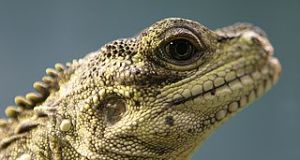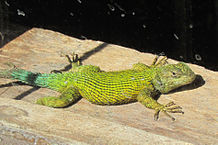 The 1,200+ skink species form the largest lizard family, Scincidae, and among them we find quite a number of unusual animals. Yet the prehensile-tailed skink manages to distinguish itself as unique in not one, but many ways.Largely unknown in the pet trade until the late 1980’s, these arboreal skinks became widely available when logging in the Solomon Islands brought their formerly inaccessible treetop homes crashing to the ground, and left the lizards in reach of collectors. I and others noticed right away that they were quite different than anything we had run across previously.
The 1,200+ skink species form the largest lizard family, Scincidae, and among them we find quite a number of unusual animals. Yet the prehensile-tailed skink manages to distinguish itself as unique in not one, but many ways.Largely unknown in the pet trade until the late 1980’s, these arboreal skinks became widely available when logging in the Solomon Islands brought their formerly inaccessible treetop homes crashing to the ground, and left the lizards in reach of collectors. I and others noticed right away that they were quite different than anything we had run across previously.
A Highly Social Lizard
The limited field studies suggest, and our captive observations support, that prehensile-tailed skinks live in hierarchal colonies (a reptilian social group is known as a circulus) and exhibit a variety of highly-developed social behaviors. Group members seem to recognize one another by scent, and mark their territories with waxy secretions. Although often found in pairs, up to 10 individuals have been collected from a single tree hollow, but the functioning of these groups is not understood.
A Placenta and a Giant Offspring
Females, which average 24 inches in length, have a true placenta. They produce 1, rarely 2, huge (to 13 inches) offspring after an amazingly long gestation period of 6 – 8 months. Esteemed veterinarian and herpetologist Dr. Kevin Wright has likened this feat to that of a woman giving birth to a 6 year old child!
Complex Parental Care
The young stay close to their mothers for some time and the females become very aggressive towards people and other skinks after giving birth. Although we do not as yet understand the interactions between adults and young, it is quite clear that those reared in isolation exhibit, if you will, “anti-social” behavior (they are noticeably more aggressive than other skinks, to the point of charging people opening the door of their cages).
Coprophagy (eating of feces) is common, and some believe that this provides the young with important intestinal flora. Breeding occurs year round in the wild and captivity. The young begin feeding at about 10 days of age, and reach sexual maturity in 10 months to 1 year.
Much More to Learn
All told, a strange and fascinating beast. Although captive longevities approach 25 years, we have yet to scratch the surface when it come to understanding prehensile-tailed skink social interactions.
The American Association of Zookeepers has posted an informative article on this species’ fascinating social structure at:
http://www.aazk.org/forum/viewtopic.php?pid=1320
 That Reptile Blog – Reptile, Amphibian and Exotic Pet Care and Information
That Reptile Blog – Reptile, Amphibian and Exotic Pet Care and Information




That is absolutely fascinating. From the AAZK link you referenced, it seems that the skink lives in a colony similar to primates.
I cannot wait to tell my class of elementary students!
Jennifer
Reptiles Alive! LLC Blog
Hello Jennifer,
Frank Indiviglio here.
Thanks so much for your kind comment, I’m very happy to see that you will be able to use the information in class. I have been a teacher myself…my compliments on your dedication.
The skinks truly are quite unique among lizards. A group of females I kept at the Bronx Zoo established a very marked hierarchy – a mere glance by the dominant animal was enough to cause another to leave a favored basking site, and the animals fed in a very specific order. Interesting that you mentioned primates, as the same occurred to me more than once, especially when rotating between gelada baboon and reptile care!
In teaching, I have used prehensile-tailed skinks to open my students’ eyes to the importance of looking deeper into everything…no one, not even seasoned herpetologists, expected to find such complex social behaviors among lizards. Furthermore, most of what we have learned about this species resulted from pet-keepers’ observations, as the skinks were not popular in zoos when they were first imported into the US. Field studies are still virtually non-existent…a colleague of mine tried, but funding was impossible to arrange.
Amazing interactions are to be found among animals where such are least expected – earwigs caring for young, fiddler crabs “fooling” others as to their actual size/strength, slimy salamanders changing their hibernation season and feeding habits so as to take advantage of an artificially created shelter within their habitat….from my own experience, I know that even in the middle of NYC, children can discover something new.
The skinks offer a good conservation message as well…they poured into the pet trade when most of the trees in the Solomon Islands were being felled for lumber…prior to that, it was difficult to find them in their canopy retreats. Limited to a few small islands in the wild, these skinks may soon be found only in captivity, so understanding their natural history and how to breed them is a priority.
Thanks again, please feel free to write in with any questions or comments, and please let me know how your students responded to the skink information.
Best regards,
Frank Indiviglio
I just saw this skink on the discovery channel and I’m amazed! I would have never imagined such a reptile. I have a blue tongue skink so this was very interesting to me! I also enjoyed your article about them! I will continue to read up on them!
Hello Madalena, Frank Indiviglio here.
Thanks for your interest in our blog and for the kind words.
Prehensile tailed skinks surprise even the most experienced herpetologists, and really what we know is just the tip of the iceberg. There is so much unknown, and surprising, about all sorts of creatures that we consider to be “simple”. Concerning skinks, for example, Australia’s shingle back forms pair bonds that may last for 20 years in the wild….and, the pair splits for a few months (maybe to maintain harmony!?) and then they find each other when its time to breed and stay together for the remainder of the year! Insects, spiders, fish…all have amazingly complicated lives.
Good luck, keep up your reading and please let me know if I can be of any help with questions or observations.
Best regards, Frank Indiviglio.
I have looked after my monkey – tailed skink for about 22 years. I inherited two, assumed they were brothers (or sisters) but one died about 20 years ago. I took the surviving skink to the vet for a check – up. He thought it ‘wasn’t a young skink’ then. After a vitamin and antibiotic injection, the skink came over to me, looked at my caring arms, and bit me!
He (I call ‘him’ Dave) eats all kinds of fruit – kiwi, oranges, figs, tomatoes etc but likes whole french beans as well. He hates it if I mix up more than one food at a time. He is grumpy, and kind of ‘hurrumps’ by breathing out, if he is disturbed.
Hello Ian, Frank Indiviglio here.
Thanks for your interest in our blog and for the most interesting post. Congrats on a fine job. You are right up among the record-holders, in terms of age. The published longevity for that species is 24 years…unfortunately, the record-keeping system that had long been used by zoos is now defunct, so no real way to determine if the older animals on it are still alive. But, especially considering that yours was not young, you have done very well.
I have found similar “personality quirks” among these interesting lizards…very individualistic and yes. Thanks for the note on its feeding habits – good to hear about successful diets, and his “pickiness”!
Good luck and please keep me posted….I hope you have him for decades to come.
Happy Holidays, Frank Indiviglio.
How common it is now in captivity? Has it been bred successfully? Are there captive offspring available? What is its status in the wild now? Observe how unsuccessful a species it is. It is very social and intelligent, but it is extremely slow breeding and has evolved in small, isolated places with few or no mammalian competitors and predators. Other australian social skinks of the egernia group are the same. Why reptiles from more competitive continents are usually smallish, fast breeding and simple in habits? Crocodiles and monitors can be exempted. Notice also its extremely energy innefficient reproduction. Also, how does that skink move on the ground? Does it creep like other skinks, or can raise itself of the ground like most lizards? Could suminia, the permian premammalian herbivorous arboreal dicynodont synapsid with the monkey like limbs have a similar lifestyle? Thank you very much.
Hello,
Pairing them up can be difficult, but they breed readily once compatible. Availability varies by year and country. Threatened in the wild – the Solomons are heavily logged.
They move well on the ground, although not quickly. Reproduction etc is keyed to the environment – we can’t really rate as “efficient” etc. Best, Frank